One of the best things about my current school is that the students push me to rethink practices that I’ve taken for granted in the past. They even push me to rethink practices that I’ve put lots of effort and intention into developing, like my final exams.
“Can we have a group test?”
I’m in my 3rd year at this school, but as we neared the end of my first trimester here, my 10th grade physics students wanted to know what my final would be. They told me that at a progressive* school, I should give them a project or have them do a presentation. Neither of those sounded good to me, but I heard them asking me to come up with something that wasn’t just a test. What I did for them that year was one of the seeds for what I’ve been creating these past two years.
The following summer, I heard a talk at the AAPT Summer Meeting by Joss Ives about 2 stage collaborative group exams, and that idea also got me thinking about my next iteration of an active physics final.
The last piece came from trying to think about what I valued in my class and how that lined up (or didn’t) with what and how I assessed my students. What would a performance task look like for this sort of class? What does it mean to have and show mastery in a high school physics class?
Final Assessment #Goals
After thinking about it, here’s what I decided that I wanted to accomplish.
- The exam should be an experience, not (just) a test. It should be a performance-style assessment.
- Students should get a chance to see that the problems they have done on paper really do work in the “real world”. They should see that physics lets you make predictions that check out.
- Our class is a collaborative experience—so our exam should be, too.
- Students should get to experience and feel some success in applying the skills they’ve learned.
- The final assessment is a performance—it should be (at least a little bit) fun!
I already have a good idea about what each student can and can’t (yet) do individually because we assess a lot. (19 quizzes in 10 weeks. Seriously. A lot.) Another data point of the same type probably wouldn’t help me or them learn anything new, so I figure that I should try measuring differently.
So. Here’s where I am now. I started trying this new format last year in my one-trimester long 10th grade physics classes, but I’ve refined it this year in my yearlong mechanics and chemistry classes. I’m going to talk about it from the physics point of view here to start (and I plan to give more details in future posts).
A Collaborative Lab Practicum Group Exam (11th Grade Physics: Advanced Mechanics Version)
When the students enter the room for the exam, they choose a card with a number on it. Then they go and sit wherever they find the envelope that has the number they chose. The tables are grouped together to make the best use of space in the room, so students are sitting near each other, but no one at their table is going to be in their group during the rest of the assessment. The groups are totally random, and I have no idea which students will get which tasks until they are starting the test.
Part 1: Individual Planning or Warm-up Exercises
The first part of the exam is done individually. Students open their envelope and work on whatever they find inside. I usually give them around 15 minutes or so, and I let them come in a little early if they think they might want or need extra time.
In the fall, I had students spend the individual portion planning for their task. They couldn’t take any data or make any measurements. They weren’t supposed to “solve” the problem yet. Instead, I asked them to decide which models seemed most useful and draw the diagrams corresponding to those models for the situation at hand. They could start making a plan for how their group might approach the task.
I liked the idea of individual thinking and planning before getting started in groups, but I didn’t think it was working very well the way that I was doing it. Some of the tasks are difficult to understand when they are just described on paper (or it really makes more sense to interact with them first and maybe make an initial measurement or two before really getting started). Almost none of the groups seemed to follow plans that had anything to do with what the individual members wrote ahead of time, and I wasn’t sure whether the solo planning was helping them be more successful as a group.
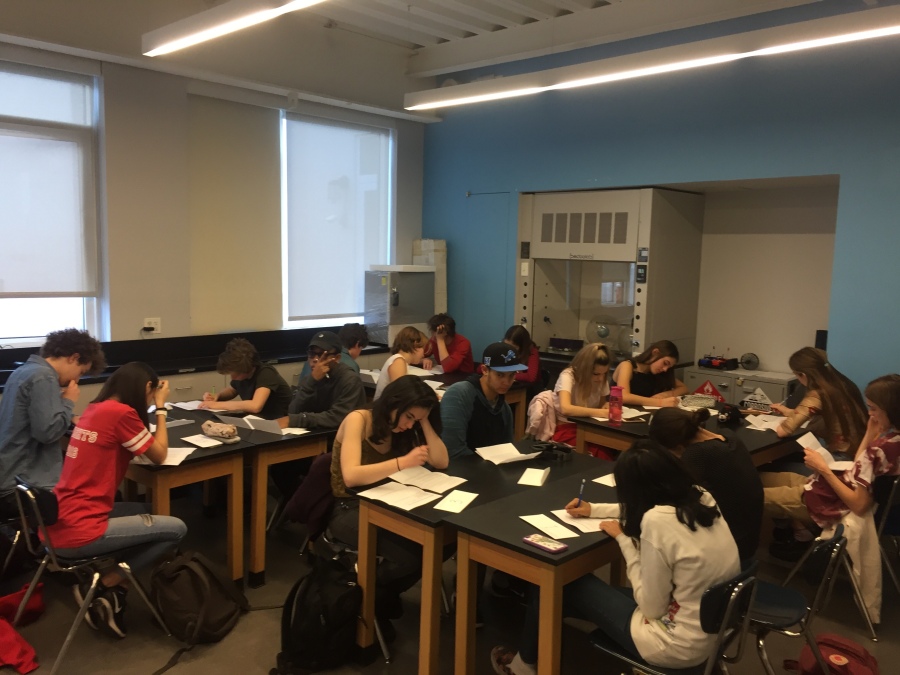
For the winter, I took a different approach to this first part of the exam. Instead of a description of their task, each envelope had a page of warm up exercises that were loosely related to aspects of the task that their group would be assigned. It would have been difficult for a student to predict their task based on just these questions, but I was hoping that it would get their brains going and ready for more challenging physics.
In any case, students turn in their paper and envelope before moving on to the next part. Since the next part involves groups, they have to wait for a few minutes for everyone to be ready.
Part 2: Group Lab Practicums
Once I have everyone’s envelopes, I give them a brief orientation about which task is in which part of the room so they know where to go. (They either knew the task in Tri 1 or the group number that they were assigned in Tri 2 from what was on the paper in their envelope.) I spread these stations around the room and try to use the space as best as I can. I’ve put some tasks in the hallway before, too. This part is where they first find out who is in their group for the test.
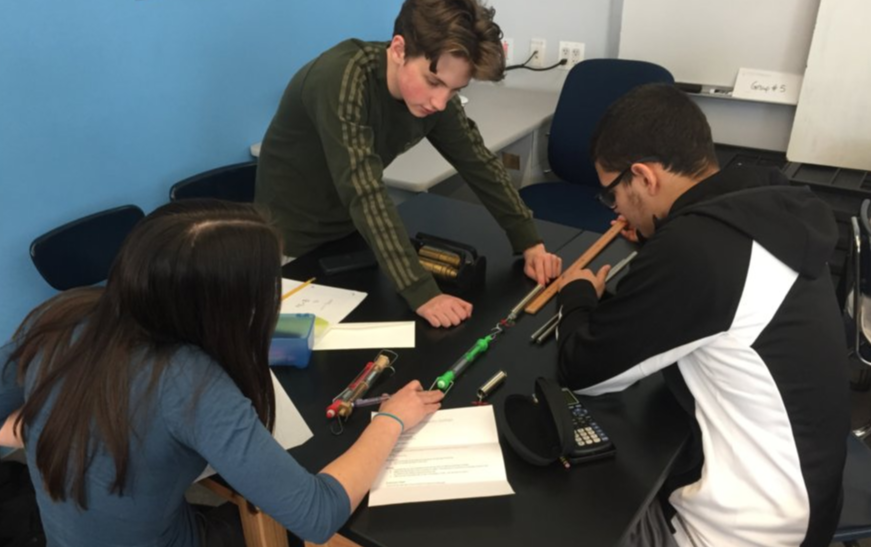
In Tri 1, I had 20 students in the class and split them into 5 groups of four. In Tri 2, I had 21 students in the class (long story), so I split them into 7 groups of three. The smaller groups were much better, so I’m going to aim for groups of three from now on. In both cases, every group had a totally different task.
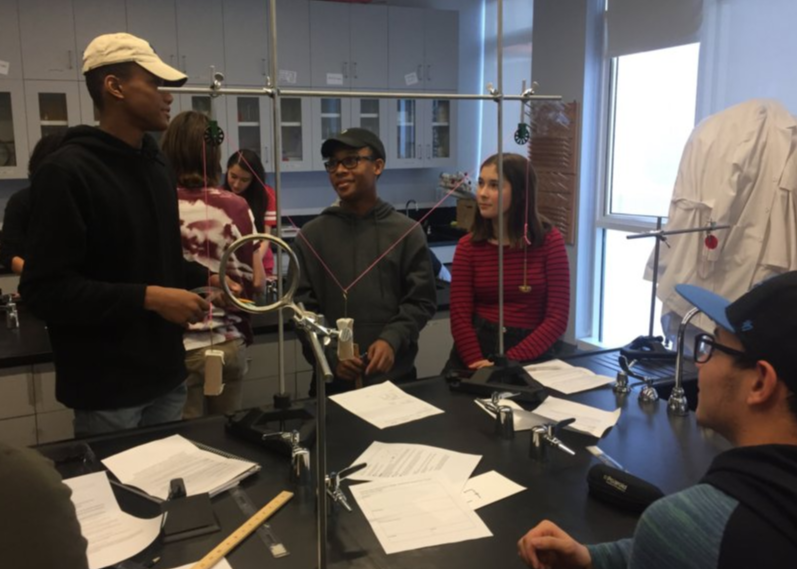
Each task comes with a single instruction sheet and some loose leaf paper.
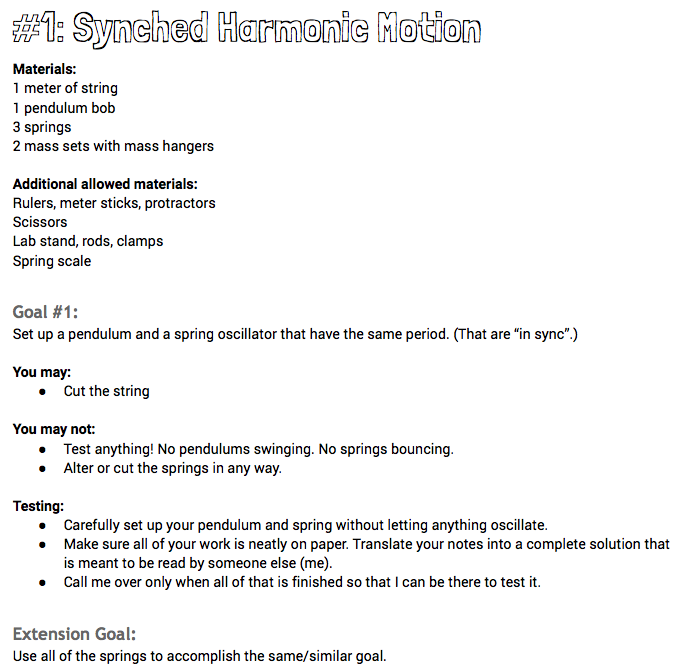
Since all of the groups have different tasks, I need to be sure the info sheet has enough on it to get them started without me being there to explain much. For the first part, I mostly spend my time going around and observing to make sure each group is understanding what the task is asking them to do. After a while, I’m doing that, talking to groups a little here and there, and being present for groups to test their results.
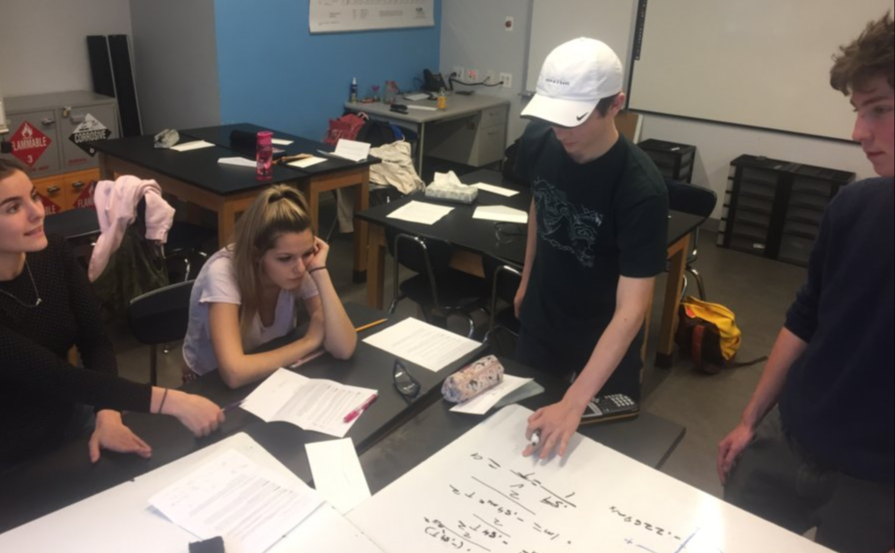
Many of the groups had multiple tasks to complete. I wanted them to have too much to do so that most groups wouldn’t finish everything in the time that we had. I wanted them to work the whole time and feel that they were doing something that was still in progress, especially since this class wasn’t ending after the final. Even though it was a ton of extra work for me, I wanted every group to have a different task so that groups couldn’t compare themselves to each other for being faster/slower/”better”/etc.
I’m going to save the descriptions of which tasks I chose and what I was looking for to make a good exam practicum for another post (since this one is definitely getting long enough already).
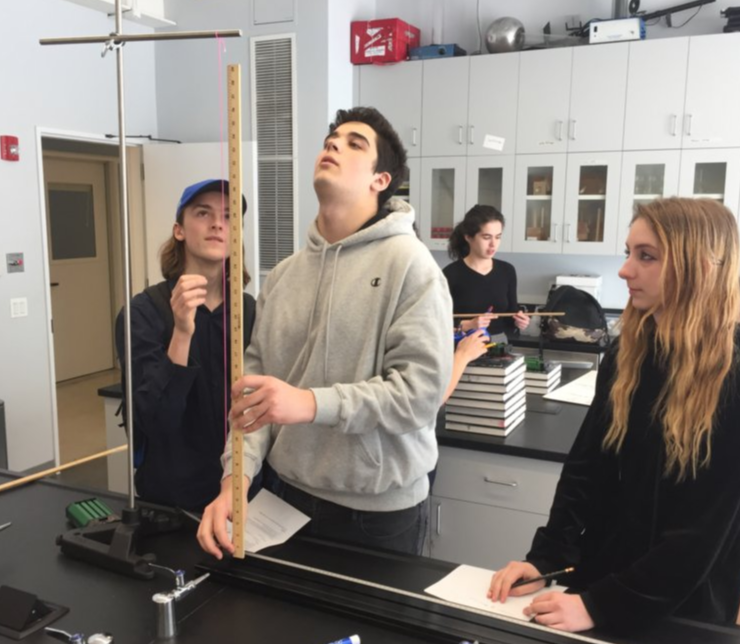
One improvement that I made in Tri 2 was to tell them that they shouldn’t be turning in their scratch work. They could do scratch work wherever they wanted (and I put paper and whiteboards at every station to help facilitate that), but once they thought they had a solution, they needed to sit down and write one nice copy for me that I could actually follow. In the first trimester, following their work was nearly impossible since so many students were working on so many papers and there was basically no way to know what order any of it happened.
Part 3: Individual Reflection
Near the end of the (two hour) exam period, I stopped groups if they weren’t already finished and asked them to help me clean up the room and to do an individual reflection about the activity.
For the winter exam, I did a Google Form instead of a paper reflection. I asked:
- How did your group do at your task?
- How did your group do as a group?
- How did YOU do today?
I also asked them whether this exam gave them an opportunity to use different ways of being “smart” in physics, whether they would prefer a more traditional paper-and-pencil test, and gave them a chance to tell me about anything I hadn’t asked specifically.
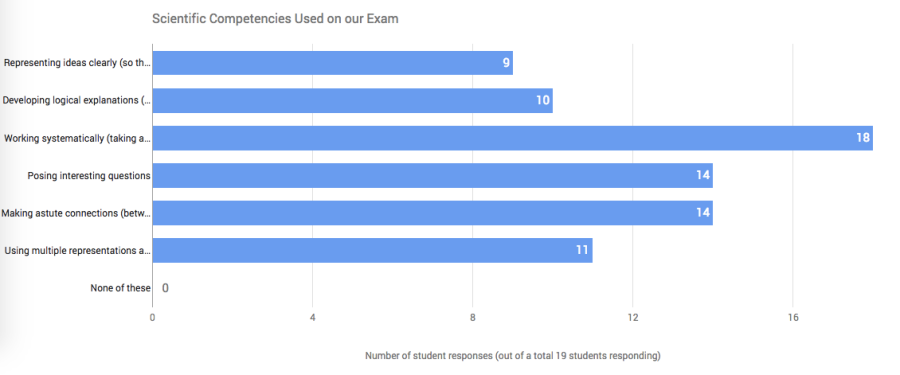
Here’s a sample of some of the things they wrote in response to the first set of questions:
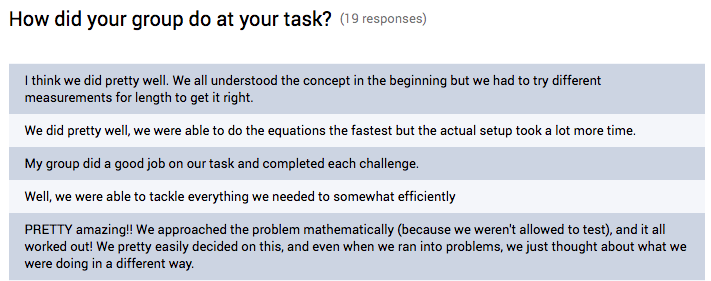
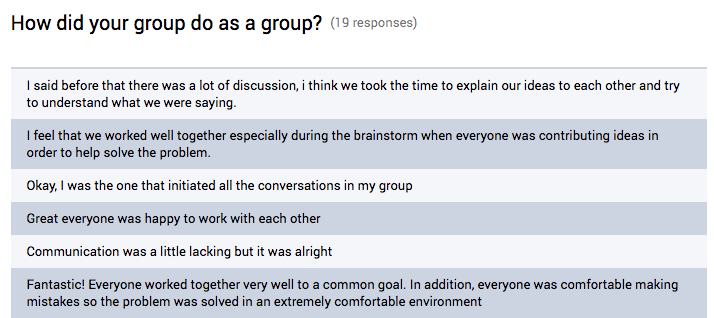
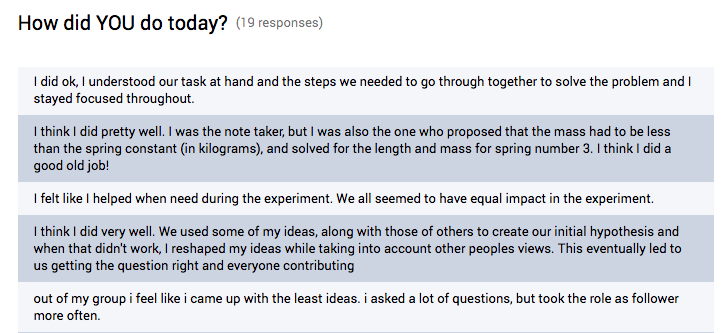
Student Feedback on the Assessment
And here’s some of the other feedback that I got from students about the assessment itself.
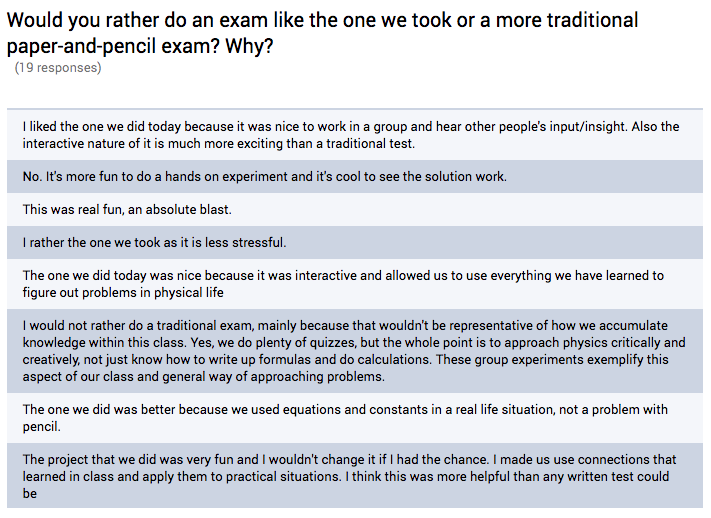
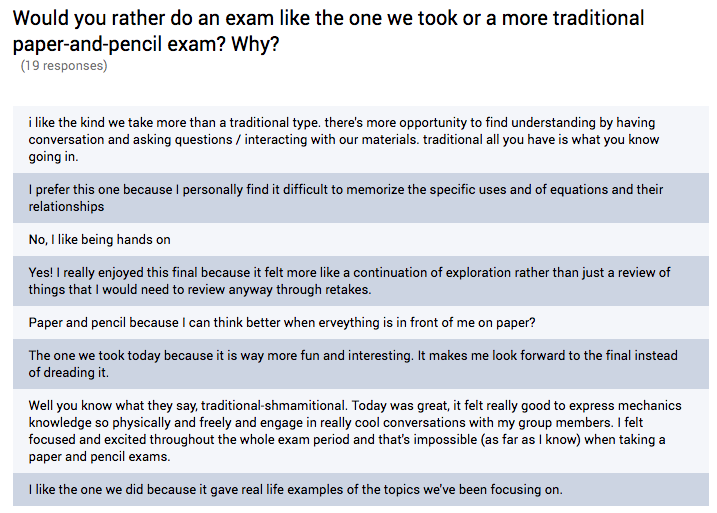

I didn’t tell these kids anything about my 5 goals, but their feedback seems to hit all of them. I want to give some extra attention to things the kids said that really affected me. I’m adding the emphasis.
I would not rather do a traditional exam, mainly because that wouldn’t be representative of how we accumulate knowledge within this class. Yes, we do plenty of quizzes, but the whole point is to approach physics critically and creatively, not just know how to write up formulas and do calculations. These group experiments exemplify this aspect of our class and general way of approaching problems.
And a different student:
i like the kind we take more than a traditional type. there’s more opportunity to find understanding by having conversation and asking questions / interacting with our materials. traditional all you have is what you know going in.
I love that both of these students see the exam as being connected to how they learn science in our class. And that a pencil-and-paper exam wouldn’t be the same. They wouldn’t learn anything new that way—they would just show what they’ve already done.
Here’s a different student:
Well you know what they say, traditional-shmamitional. Today was great, it felt really good to express mechanics knowledge so physically and freely and engage in really cool conversations with my group members. I felt focused and excited throughout the whole exam period and that’s impossible (as far as I know) when taking a paper and pencil exams.
What more could you want students to think about the experience, really?
I didn’t ask specifically about the warm-up exercises, but several students commented on them.
This past exam period deserves two thumbs up! I really liked the initial practice problem- it didn’t directly relate to our assignment but it was a lovely prelude, like a clue we could keep referencing.
One student told me in person (and wrote it in the feedback, too) that he felt his thinking was limited by the warm-up exercise. The paper problem had been about projectiles, and the practicum required him to use that skill in combination with other skills (probably energy conservation), but he didn’t realize he needed more than just that. So there’s probably something more for me to think about in how I frame that individual portion.
Creating the Exams
I had a lot of help in creating these assessments—from physics teachers that I collaborate with regularly online to my school’s academic dean to advice all the way from Latvia (Danny and I will be leading a workshop at this summer’s AAPT meeting about creating assessments like this one). For my 9th grade chemistry students, I couldn’t have made their assessment happen without my colleague, Alan.
I plan to write another post all about that chemistry exam and at least one more about the specific tasks that I’ve used in physics.
Coming up next:
- Blog Post Part 2 (9th Grade Chemistry Exam)
- and Part 3 (More details about Physics)
- STEMteachersNYC workshop in May about creating and using these assessments
- AAPT workshop in July with Danny Doucette
- Figuring out: How do I grade this? (No really—how do I grade this?) (Blog post Part 4?)
Resources:
- Measuring the Learning from Two-Stage Collaborative Group Exams One of the things that got me started on this path.
- Two Stage Exams Literature Roundup that I found in a quick search (and now need to read more about!)
- Lab Practica page on the legacy ASU Modeling site
- Practicums for Physics Teachers book PDF
* Sometimes (not all the time) “progressive” seems to mean “easier” to the students (and I think that was the case here), but I still took the note. I think I’ve come up with something that is both “easier” and also much, much more challenging than what I used to do.
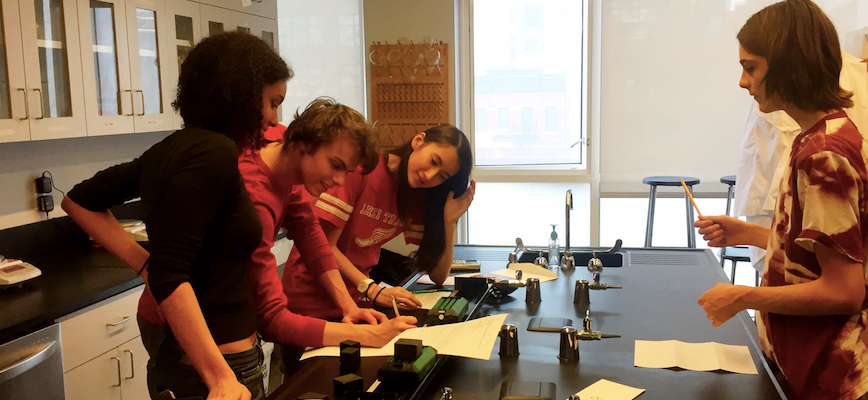

I love your willingness to try new things!!!!
There have been so many times when I’ve said I need to give traditional assessments because tradition says that’s how individual achievement is measured by universities, the College Board, IBO, and other traditional organizations like them.
As your student said, “traditional, shmamitional”.
I’m still not confident in my ability to parse the results of an assessment like yours for individual understanding, but that’s my issue, not yours. Thank you for sharing another innovative way forward!
I have no idea how to use it to assess for individual understanding either—but I’ve also decided that’s just not what I’m trying to do with this assessment. It’s more of an opportunity to perform and to use other skills (like science practices/scientific abilities). I would like to have some way to give individual feedback, but I’m not sure how to do that given the number of students and how many things I need to do while they are working (I just can’t observe enough to give everyone great and useful feedback). I’d also like a useful way to give a grade for it—mostly for other teachers who might want to try it (I’m okay with not really grading it in my own classes right now).
Agreed KO! I did something similar(but not near the detail) for our wave nature of light assessment. I’m still shocked at the focus for 99% of the students. No individual grading but they definitely had a more positive assessment experience!
[…] Joss Ives‘s work on two-stage collaborative exams and by conversations and collaboration with Kelly O’Shea, with whom I will be presenting a workshop on the topic this […]